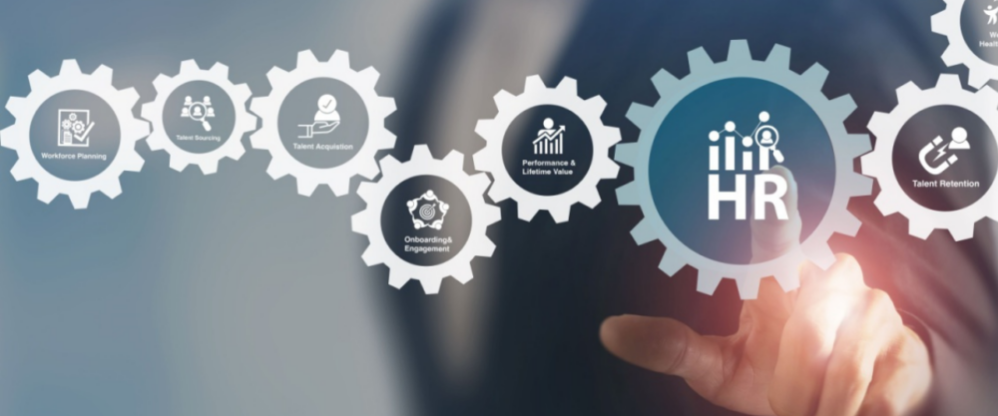

As a HR professional, you’ve likely witnessed the evolution of HR systems from standard administrative tools to strategic drivers of organisational success. You also understand their role in compliance, privacy, efficient employee management, and cross team collaboration thanks to software integrations with functions like payroll and learning and development.
As specialist HR recruiters, we’ve also seen the impact of HR systems on hiring. Features like applicant tracking and AI candidate-selection algorithms streamline recruitment and create a positive employee experience from day one. Self-service options empower employees to manage their data, request leave, and track performance independently, ultimately enhancing engagement (and reducing manual tasks for you).
With the market brimming with competitive options, selecting the right HR system can feel overwhelming. But fear not! Here’s our comprehensive guide to choosing and implementing the perfect solution for your organisation.
Making the right choice for your organisation
Understanding the different types of HR systems
HR systems come in various forms to suit specific organisational needs. The three main types of HR systems are Human Resource Information Systems (HRIS), Human Capital Management (HCM) software and Human Resource Management Systems (HRMS).
Popular examples include Oracle Cloud HCM, Sage People or Paycor (more examples and comparisons here). Other common types are:
- Applicant Tracking Systems (ATS), which streamline recruitment by automating job postings, candidate screening, and interview scheduling (e.g. Bullhorn or Greenhouse):
- Learning Management Systems (LMS) facilitate employee training and development by offering online courses, tracking progress, and assessing performance (e.g. Thrive, TalentLMS or Cypher Learning).
Of course, choosing the right type depends on your company’s size, industry, and specific requirements. Small organisations may benefit from an all-in-one HRIS, while larger ones might prioritise a robust ATS for extensive recruitment needs.
While scanning options, make sure to consider these key metrics:
- Business size and scalability: Does it fit your current organisation size and offer scalability for future growth?
- Features and functionalities: Which HR processes and functionalities do you require?
- Integration: Can the system seamlessly integrate with existing software and platforms to avoid compatibility issues?
- User-friendliness and customisation: Are the systems intuitive to use and do they offer customisation options to adapt to your unique requirements?
- Vendor reputation and support: Have you researched the reputation of HR system vendors, their track record of customer support, and the reliability of their solutions?
- Cost and budget: What’s the total cost of ownership, including initial investment, ongoing maintenance, and potential scalability costs – and does it align with your budget?
After you’ve answered these questions, shortlist your potential options and vendors based on the identified criteria, then request demos or trials to evaluate suitability.
In the meantime, you will be able to gather feedback from key stakeholders (making buy-in easier later) and conduct a cost-benefit analysis to make an informed decision.
Finally, you’ll be able to develop an implementation plan outlining timelines, responsibilities, and milestones for a smooth transition to the new HR system.
Overcoming implementation hurdles
Congratulations on choosing your HR system! Implementing HR systems can present challenges for many organisations. The most common issues we’ve observed usually revolve around resistance to change, data migration, and the practicalities using a new system.
To ensure a seamless implementation process, consider the following:
Secure stakeholders buy-in
Highlight the benefits of the new HR system and address concerns to secure buy-in from stakeholders across your organisation. Using the feedback you collected, preparing answers for foreseeable objections will help – which the provider should be able to support you with.
Additionally, identify and appoint superusers who will act as advocates and assist in training future new starters in the business. These individuals can offer insights and support throughout the implementation process, helping to drive adoption and maximise the benefits of the new HR system.
Training and support
Many people are surprisingly resistant to change, even when it brings positive outcomes! To ensure smooth adoption, you must provide comprehensive training to users to familiarise them with the system and maximise utilisation. This is also an area where the provider should offer support during your onboarding.
Communication channels
Set up clear communication channels to address questions, concerns, and feedback from employees throughout the implementation process. Consider creating a dedicated Teams or Slack channel for software-related queries, allowing people to learn from each other’s questions and experiences.
Phased implementation approach
Minimise disruption by adopting a phased implementation approach, allowing for gradual adjustment to the new system. Each phase will provide valuable insights and lessons that can guide and improve the following stages, making the transition smoother and optimising the overall implementation.
Reviews
Identify areas for improvement through regular reviews and optimisations to maximise ROI.
In conclusion
Investing in the right HR system is essential for organisational growth and competitive success. As organisations expand, they become vital for productivity, informed decision-making and compliance. Evaluate your needs, select a suitable system, and implement it effectively to streamline HR processes and drive success!
We’re a Cardiff-based recruitment agency leading HR talent to the heart of your organisation. Contact us now for expert guidance and find the perfect fit for your HR team!
To find out how we can work with you, please drop us a line

In all honesty I don’t think there was anything Sitka could have done differently. It was a time when we were struggling to get any applicants for various reasons. To find someone as good as we did is testament to the hard work Karen put in. We would never have found that candidate if we hadn’t used an agency like Sitka and Karen.

I was thrilled when I was offered my new job, which I felt was down to Sitka’s support and proactivity. Karen kept in contact and made sure I was happy in my new role. This personal and professional service is second to none. I would highly recommend!

The experience of working with Sitka was really enjoyable. It was like talking to a friend who knew all the answers to my future career.

This was the most professional recruitment processes I have experienced as a candidate. I felt really well prepared for the hiring process. Ita took the time to understand my experience and align my skills and values with those of role that I was applying for. This meant that I felt really prepared for the interview process and confident that I understood the role, culture and values of the organisation.
I would recommend Sitka and I would also consider using them as a client in the future. Having experienced their service as a candidate I have seen the effort that is made to ensure there is a good fit between candidate and client. Thank you Ita!

Ita took the time to ask about our business, our culture, the role and really understood what we were looking for. This resulted in a really straightforward recruitment process. All of the candidates put forward were of exceptional quality and I would definitely recommend Sitka to my colleagues and network.

The process was thorough and very individual – time was spent finding out about the culture and style of the organisation and the exec team. Sitka worked with the candidates well to find the best fit for both employer and candidate. There was a sense of strong relationship building to ensure that this happened.